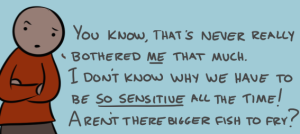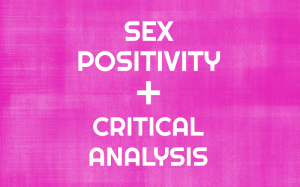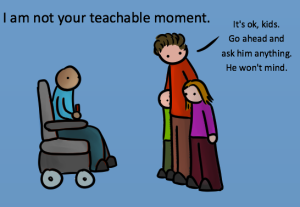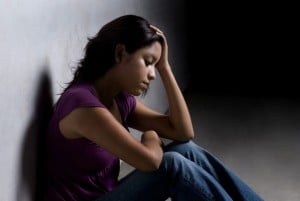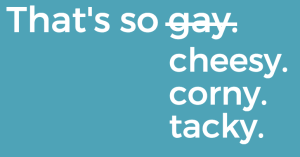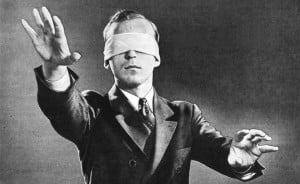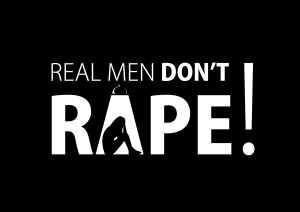I’ve been working in the field of sexual violence for a few years now, and I can’t help but have noticed this quirky little trend: Some survivors are treated as “good” and some survivors are treated as “bad.”
And here’s what I mean by that:
Some survivors who I meet have long lists of everyone who has treated them with kindness and gentle compassion in response to their assault. They can name the teachers or professors who gave them extensions on assignments, the church members who held their hand and believed every word they said, the professionals in the field who honored their truth and supported them on their own terms.
And then there are survivors who I meet who have run up against every single barrier imaginable in the face of sharing the story of their assault: the community members who gave them a side eye, the doctors who told them to have “less rough sex” rather than treat injuries that came as a result of a forceful and violent crime, the advocates who didn’t take their voices seriously or who encouraged them to do something differently next time.
This is so fucked up. And so common. And so real.
There are people who have access to high-quality survivor-centered services to support them in healing, whatever that means to them. And there are people who do not encounter a single person who gives a shit about what happened to them.
And I bet that using a social justice lens, we can all guess who fits into category one and who fits into category two, can’t we?
But what might come as a surprise is that this split – between the so-called “good” survivors and the “bad ones” – actually dates back to the 16th century.
And understanding where this bullshit comes from is an important step of eradicating it today. So let’s learn – and then deconstruct – together.
Way Back When…
At the time (and we’re talking Medieval Times, okay?), European society was feudalist – which is just a fancy way to say that society was structured based on who held land and who was bound to labor on that land.
And under these customs, anyone who was bound to labor (they were called serfs, by the way) earned the “right” to food, healthcare, and housing by virtue of working on the manor.
And with the eventual breaking up of feudalism came the responsibility for the prevention and intervention of poverty came to rely solely on the community – rather than, supposedly, the individuals.
So, instead of everyone having a job as a serf and having all of their needs met through serfdom, communities had to figure something else out. And that meant deciding who would receive social support and who wouldn’t.
Kind of like how we handle social services now, right?
So what came next – Statute of Laborers of 1534 and later The Elizabethan Poor Laws of 1601, if you want to read into them – divided social welfare responses by splitting people into two categories: sturdy beggars and the impotent to serve.
And those may sound like fancy phrases, but what it comes down to is that these two categories could be otherwise understood as the “worthy” and “unworthy” poor.
The sturdy beggars were able bodied, and it was believed that they “should” work. The impotent to serve, however, were people with disabilities – and they were therefore exempt from work. The latter group also included young children and pregnant women, and both of these groups at the time were viewed as “worthy poor.”
And while this was literally hundreds of years ago, but the basic idea remains deeply alive in our society: There are people who should make better choices to get themselves into a more respectable social class, and there are people who – for reasons beyond their control – have fallen upon hard times and deserve a hand.
When we think about how this impacts survivors of sexual violence, the idea is the same: there are people who are worthy of support and justice – the people who, let’s say, are white virgins who were attacked by the bogey man in a parking lot. And there are people who “had it coming” and are understood as underserving of our support – like the people of color, people who aren’t straight, people who enjoy consensual sex.
The ideas of the worthy poor and worthy survivor are deeply connected in these historical roots.
And, of course, in order to become the social code, this idea has been reified over and over ever since.
A Slightly Less Long Time Ago…
Flash forward to the 1860s to 1900s, when there were several changes in the understanding of who is “worthy” and who is “unworthy” of social welfare in the United States. But note that these (albeit unofficial) categories still exist, and still determine which survivors of sexual assault have access to services.
The Welfare of Soldiers and Veterans Act of the late 1800’s created an obligation for the government to take care of veterans, and actually included widows and children in their legislation.
Cool, right? The government caring about widows and children? Yes!
But wait.
This Act resulted in a sizable increase in the wealth, status, and ability to engage in leisure activities for white women and women of privilege.
As you probably guessed, this firmly positioned white women in the class of “worthy” citizens.
White women as “worthy” – sound familiar?
This Act basically stated that what white women were worthy of was social services. And even though it was centuries ago, the idea that people who aren’t white women are undeserving of rape crisis services is alive and well, even now.
And it gets worse.
When it came to protecting children, the intention of the Act was actually to “rescue” children from dependency and criminality. The dominant fear was that if not exposed to wealth, that children would become paupers (basically, someone who’s poor and relies on welfare or charity to make ends meet).
Rather than take a cold, hard look at who had money and who didn’t, poor children were removed from their homes and placed into “proper” foster families.
Can you guess what those looked like? I bet you can: white families with money.
What that really boils down to is that societal values shifted onto wealth and class status, meaning that individuals’ class status became a deciding factor in whether they would be respected and supported by social welfare institutions.
How many recent news stories have you heard that proves this fucked up value is still real? How many 11–year–old Black girls have been blamed for their assaults, or whose parents (read: mothers) have been blamed for them?
This shit is still real, y’all.
And it continues.
The 1930s marked the beginning of Aid to Dependent Children. Wondering what that means? Feeling optimistic that this is a broad service program that’s available to any dependent child (which, let’s face it, is every child)?
Well, it’s a program that was funded by local, state, and federal governments and was intended to support children of the worthy poor – like kids whose fathers died in war and kids whose parents had disabilities and couldn’t work.
Basically, it helped any kid whose parents fit neatly and cleanly into that “worthy poor” category that we discussed earlier.
As you can guess, that left a lot of kids to fall through the cracks.
But someone, somewhere thought it was a smashing success – because in the 1950s, Aid to Dependent Children increased and began to expand its scope. It started to support kids of single parents, kids of color whose mothers were widowed, and kids whose parents just needed a financial boost.
Sounds like it was finally improving, right?
Kind of.
But state and local governments became suspicious of the purpose that it served. Governments began to question how families became eligible and what their situations were. They basically began to wonder by so many people were receiving the money and wondered if the recipients truly deserved it. (A reminder: We’re still talking about the 1950s – not yesterday.)
The government became interested in how to limit access to this funding. Not surprisingly, they came up with one of the most racist and sexist standards to exist: The Man in the House Presumption.
Under the Man in the House Presumption, if a man lived with a family, he was assumed to be financially responsible for the family. This led to a provision with a name dripping in classism: the Suitable Home Provision.
It stated that an unmarried woman who receives benefits cannot live with a man, with the unspoken idea that if she’s “living in sin,” she doesn’t deserve financial help.
In order to “catch” these women, welfare workers went to women’s homes unannounced to determine if there was a man living there, a method that became known as Midnight Raids.
Can you guess whose homes these social workers visited most frequently?
That’s right: women of color.
History is dripping with misogynoir, and the helping profession has a well-established history of only providing services to those who are deemed “good.”
And you know, all this checking to see if someone really “deserves” services reminds me of something.
Did you know that in order for survivors of sexual assault to receive Victim’s Compensation, they need to file a police report? So, rather than have the government provide funding for trauma therapy, transportation to services, or pay for things like a new lock on the door or other general safety measures for survivors, the government requires survivors to jump through a huge hoop to validate that the assault happened.
No police report? No Victim’s Compensation. That sure as fuck reminds me of these racist and classist and sexist standards on who deserved funding in the 1950s.
Now we jump to the period when some of us were born: the 1980s.
Only a Little Bit Long Ago…
The 1980s marked a huge shift towards the view of women – especially women of color and women of other marginalized identity – as unworthy poor.
You may have heard that President Reagan wasn’t an ally to the marginalized. Well, that’s really true.
During his presidency, he used his energy and power to eliminate welfare for women with dependent children. His thoughts were that because this group was the largest, fastest growing, and most expensive demographic, something had to be done to save money.
So, to no one’s surprise, women of color and poor women were an easy target to move from the “worthy” poor category to the “unworthy” group.
Reagan’s original belief was that women should be working and financially independent so that the government could save money. But then the guys in ties talked less about how to save money on welfare spending and talked more about how to make women more “productive.”
They reasoned that if women were working, not only would that require less welfare spending, but it would also boost the economy through adding to the work force.
Women were only important if they were working or if they were supported by someone else who was working.
You know how no one tells a rich white woman to stop taking her husband’s money and get a job, but people are quick to tell a poor Black woman to stop accepting welfare money and get a job?
Kind of like how I hear all the fucking time that a survivor doesn’t deserve free therapy to heal from their abuse, but a survivor with health insurance has every right to complain about their co-pay when they go to therapy.
Basically, these racist and classist ideas of women and work hold true today, and really influence who has access to services for survivors of sexual assault and who doesn’t.
Which brings us to the 1990s.
A lot was happening while many of us were infants and children: The trend toward addressing the dependence of women on welfare continued into the 1990s with President Clinton’s Personal Responsibility and Work Opportunity Reconciliation Act. (You’re probably familiar with Temporary Assistance to Needy Families or TANF, which was a part of this legislation.)
As you may know, adults who receive benefits are required to obtain and hold a job after two years of receiving benefits, at which time the benefits will end. While receiving benefits, a person must work or actively search for a job for 20 to 35 hours per week, depending on marital status.
You heard that right: The government makes a decision about a person’s eligibility for welfare benefits in part based on their marital status.
Does that remind you of anything?
It sure reminds me of all of the married survivors I work with who tell me that they aren’t believed when they say that their perpetrator was their spouse. It also reminds me of the married people who I know who have been raped by someone outside of their marriage and are then socially shamed for infidelity, as if sexual violence is the same as an affair.
Back then, someone’s eligibility for services was based on whether they were married. Now, someone’s “credibility” as a survivor is impacted by their marital status.
And that brings us to today:
Between the politics of Black motherhood and the entirely abusive and intrusive surveillance that exists for people to receive welfare benefits, it’s like the racist and sexist history of the welfare state is playing on loop.
And it continues to impact which recipients of social services are deemed “worthy” and which recipients are deemed “unworthy.”
And as intersectional feminists, we understand that no social phenomenon exists in a vacuum.
We know that these definitions of “worthy” and “unworthy” are too closely linked to who is a “good” survivor and who is a “bad” survivor for it all to be a coincidence.
***
This historical context helps us understand the way we have organized ourselves around who is worthy and who is unworthy of social services and support.
And while we usually talk about social welfare in terms of things like food and healthcare, we can use the exact same framework to understand how we’ve come to believe in “worthy/good” and “unworthy/bad” survivors.
This distinction perfectly mirrors the way we have organized ourselves around the poor for centuries – yes, centuries.
Is it any wonder that survivors with social and economic privilege are treated with more respect and dignity than those without? It is any surprise that a young, white, cishet college student who is raped by a stranger in a parking lot is going to be treated with a fuckload more dignity than an older Black woman, than a trans person, than a gay person who has an abusive partner?
Everyday Feminists, I am calling on you to change this.
Do something different. Contribute to a different story.
Understand that everyone who says they were assaulted has been. Trust that every word they tell you is true or true enough. Treat them all the way you would treat your best friend. Do better. Be better.
Rewrite history. Start now.
We’ll do it together.
[do_widget id=”text-101″]
Sarah Ogden Trotta is a Contributing Writer for Everyday Feminism and psychotherapist at ContactLifeline, Delaware’s Rape Crisis Center. She can be reached at [email protected]. Follow her on Twitter @xsogden. Read her articles here.
Search our 3000+ articles!
Read our articles about:
Our online racial justice training
Used by hundreds of universities, non-profits, and businesses.
Click to learn more






